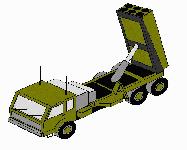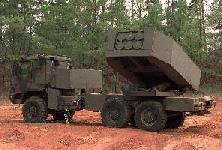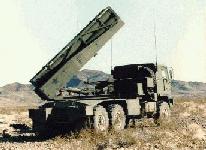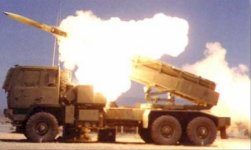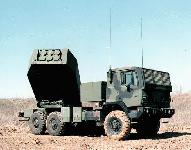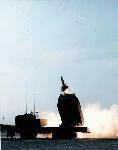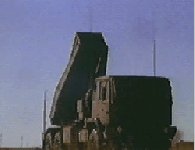 The High Mobility Artillery Rocket System (HIMARS) TD will provide a lightweight, C–130 transportable version of the M–270 multiple launch rocket system (MLRS) launcher. Mounted on a 5–ton family of medium tactical vehicles (FMTV) truck chassis, it will fire any rocket or missile in the MLRS family of munitions [MFOM]. The HIMARS launchers will some commonality with its older and heavier tracked cousins, the M270 and M270A1 launcher systems. The HIMARS design concept will include the familiar launcher module, fire control, and digital command and control systems, and a self-reload capability. The HIMARS uses the same command, control, and communications, as well as the same crew, as the MLRS launcher but carries only one rocket or missile pod. It will roll on and off a C–130 transport aircraft and, when carried with a combat load, will be ready to operate within 15 minutes of landing. The HIMARS will fire either six MLRS rockets or one Army Tactical Missile. Because of the lighter weight of using one pod rather than two, it will have a faster time,
compared to the current M270, from the point the fire mission
is received to the actual munition firing.
The High Mobility Artillery Rocket System (HIMARS) TD will provide a lightweight, C–130 transportable version of the M–270 multiple launch rocket system (MLRS) launcher. Mounted on a 5–ton family of medium tactical vehicles (FMTV) truck chassis, it will fire any rocket or missile in the MLRS family of munitions [MFOM]. The HIMARS launchers will some commonality with its older and heavier tracked cousins, the M270 and M270A1 launcher systems. The HIMARS design concept will include the familiar launcher module, fire control, and digital command and control systems, and a self-reload capability. The HIMARS uses the same command, control, and communications, as well as the same crew, as the MLRS launcher but carries only one rocket or missile pod. It will roll on and off a C–130 transport aircraft and, when carried with a combat load, will be ready to operate within 15 minutes of landing. The HIMARS will fire either six MLRS rockets or one Army Tactical Missile. Because of the lighter weight of using one pod rather than two, it will have a faster time,
compared to the current M270, from the point the fire mission
is received to the actual munition firing.
HIMARS is based on the need for a lighter weight, more deployable MLRS that can be sent anywhere in the world to provide the maneuver commander lethal, long range fires at the very beginning of a conflict. HIMARS is being designed and produced by the Army to support its Early Entry Contingency forces and its Light/Airborne/Air Assault Divisions with long-range, general support rocket and missile indirect fires. HIMARS battalion, (3x6) will be organic to FA brigades in support of light, airborne, and air assault Divisions. HIMARS will be fully interoperable with and use the same existing command and control support systems as the M270 and the M27OAl launcher. HIMARS will also utilize the standard Army Logistical Support System. The purpose of HIMARS is to engage and defeat tube and rocket artillery, air defense concentrations, trucks, light armor and personnel carriers. It also supports troop and supply concentrations. Deployment of HIMARS makes it very difficult for an enemy force to launch a counter attack. HIMARS is able to launch its weapons and move away from the area at high speed before enemy forces are able to locate the launch site.
The HIMARS (launcher) will consist of a carrier (automotive portion) and a Fire Control system (FCS) that computes all fire mission data and a Launcher-Loader Module (LLM) portion that will perform all operations necessary to complete a fire mission. The HIMARS will also conduct reload operations with the use of a reload arm assembly. HIMARS retains the same self-loading and autonomous features installed on the Multiple Launch Rocket System (MLRS). The Improved Launcher Mechanical System (ILMS) upgrade and electronics of the Improved Fire Control System (IFCS), now being implemented onto MLRS M270 launchers, will be standard equipment on production HIMARS vehicles. HIMARSí fire control system, electronics and communications units are inter-changeable with the MLRS M270 A1 launcher. The crew and training are the same as the current system. The launcher unit is equipped with an onboard land navigation system. This allows the crew to remain within the safety of the armored cabin while accurately monitoring their position.
HIMARS is operated by a crew of three - a driver, gunner and section chief - but the computer-based fire control system enables a crew of two or even a single soldier to load and unload the system. The fire control system includes video, keyboard control, a gigabyte of program storage and global positioning system. The fire control computer allows firing missions to be carried out in automatic or manual mode.
The HIMARS is mounted on the Armyís new Family of Medium Tactical Vehicles (FMTV) 6x6 all-wheel drive 5-ton truck supplied by Stewart and Stevenson, Texas. This system uses a wheeled transport vehicle versus the tracked transport system of MLRS. The HIMARS vehicle will carry a single six-pack of rockets and weighs approximately 24,000 pounds compared to the 12 rockets and more than 44,000 pounds for the MLRS M270 launcher.
The first firing was successfully conducted on 20 May 98, at White Sands Missile Range. Two single-rocket missions were fired at 90 degrees azimuth (left side), one at 51 degrees elevation and the other at 11 degrees elevation. After verifying data collection and safety, a three round ripple was fired at 90 degrees left azimuth at each of the two elevations. Preliminary data and physical examination indicate nominal performance by the launcher, with no noted malfunctions or damages.
The second firing iteration was conducted on 27 and 28 May 98. On the 27th, two three-round ripple missions were fired, followed by a six-round ripple. All three missions were at 90 degrees azimuth (left side) and approximately 22 degrees elevation. In the six-round mission, fuzes were set and warhead event was successful on all rockets. On 28 May, a single rocket, a three-round ripple and a six-round ripple were fired at 60 degrees azimuth (left side) and 22 degrees elevation. Preliminary data and physical examination indicate nominal performance by the launcher, with no noted malfunctions or damages.
Only MLRS M28 practice pods were fired and all launches were fired from the side of the HIMARS prototype launcher. The maximum range of the initial rocket firing was 35 KM. The second rocket fired flew at a minimum range of 17 KM. The initial ripple firing consisted of three rounds fired at a range of 35 KM and the second ripple firing at a range of 17 KM. All test objectives were met.
The highly successful HIMARS Program continues to receive strong support from the Armyís senior leadership and the United States Congress. The HIMARS Advanced Technology Demonstration (ATD) Program, which supported the Rapid Force Projection Initiative Advanced Technology Demonstration (RFPI ACTD), formally transitioned into the HIMARS Maturation/Acquisition Program. The programís number one goal is to quickly field the first HIMARS battalion by the end of fiscal year (FY) 2004.
Three deployable HIMARS prototypes were built and delivered to 3/27th FA FORT BRAGG, NC. 3/27th FA manned a fully deployable HIMARS platoon and received New Equipment Training (NET). The platoon participated in the Rapid Force Projection Initiative/Advanced Concept Technology Demonstration (RFPI/ACTD) at Ft Benning, GA in FY98. The three prototypes were delivered to the unit six months prior to the start of the RFPI/ACTD field exercise to allow time for NET and platoon certification.
The three prototype Launchers, presently assigned to the 18th Corps Artillery at Fort Bragg, NC, continue to remain on station in support of the RFPI two year Extended User Evaluation (EUE) program. The daily use and assessment of these mission capable prototype launcher systems has been an invaluable source of information to the MLRS PMO on the prototype system performance.
On 22 December 1999 Lockheed Martin Corp., Missiles & Fire Control-Dallas, Grand Prairie, Texas, was awarded a $2,000,000 increment as part of a $68,320,142 cost-plus-award-fee contract for the High Mobility Artillery Rocket System (HIMARS) for a lightweight launcher, which is C-130 transportable. The contractor will deliver six maturation launchers under this contract. Work will be performed in Grand Prairie, Texas (87.2%) and Camden, Ark. (12.8%), and was expected to be completed by Dec. 31, 2002. This is a sole source contract initiated on Oct. 1, 1999. The U.S. Army Aviation & Missile Command, Redstone Arsenal, Ala., is the contracting activity (DAAH01-00-C-0002).



